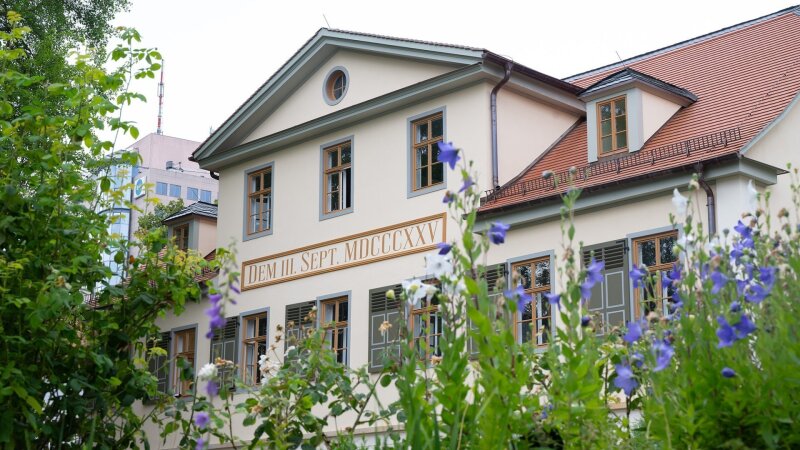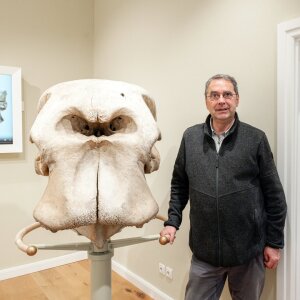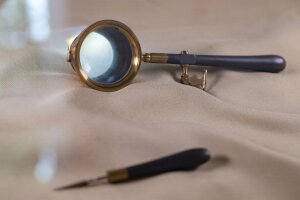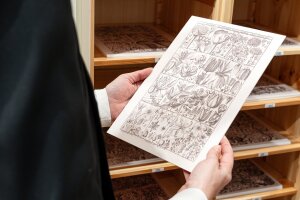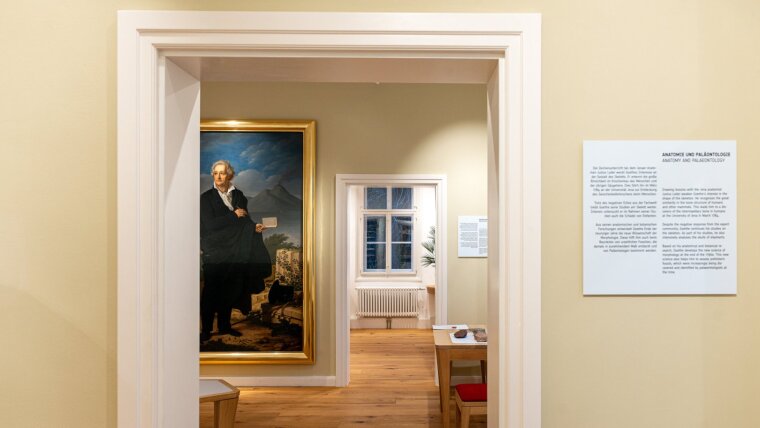
Johann Wolfgang von Goethe was a poet, statesman and science minister. Less well known, however, is his work as a naturalist. He devoted himself to subjects including geology, mineralogy, anatomy, botany, colour theory and meteorology. Goethe’s passion for the sciences is now the subject of a permanent exhibition which opened at the renovated and modernized »Inspector’s House« in the University of Jena’s Botanical Garden in the summer of 2024. Our author paid a visit.
By Irena Walinda
Shortly before Christmas, I find myself walking along Fürstengraben, heading for the Inspector’s House in the University of Jena’s Botanical Garden. I want to meet with Dr Helmut Hühn, who had agreed to guide me through the permanent exhibition, »Mobile Order« (»Bewegliche Ordnung«), at the Goethe Laboratory. I had already spoken with him about an elephant skull that was on display. All the same, I was unsure how the »Laboratory« would present Goethe as a naturalist. That was about to change on that day.
Exterior view of the »Inspector's House« in the Botanical Garden of the University of Jena
Image: Jens Meyer (University of Jena)The Inspector’s House is roughly 200 metres from the JenTower as the crow flies. As I enter its inner courtyard and the city’s noise slowly fades, I feel as if I have travelled back in time—to the first third of the 19th century. Goethe repeatedly spent time in the Inspector’s House from 1817 onwards, ultimately ordering its reconstruction to mark the 50th anniversary of Grand Duke Carl August’s accession. Following over a decade of laborious renovation work, this classicist structure has now been restored to its original splendour.
During the warmer months, the inner courtyard is a place for guests to enjoy the scent of roses dating back to the 18th century, or marvel at the ginkgo tree planted in Goethe’s time. Visitors to the exhibition today can view the tree from much the same perspective as the poet and naturalist himself. I am pleased that I already feel a close connection with Goethe. A true polymath, he is depicted at the entrance to the exhibition against the backdrop of the Gulf of Naples in a life-size portrait by Heinrich Christoph Kolbe.
Here I am welcomed exceptionally warmly by Helmut Hühn, the Director of the Goethe Laboratory. As we start our tour of the exhibition, he tells me that I would, in fact, also be taking a journey into myself. »Researching nature always means finding out something about yourself, too,« he says.
Author Irena Walinda (left) holds a granite stone in her hands and talks to Dr Helmut Hühn.
Image: Nicole Nerger (Universität Jena)Geology and meteorolgy
Goethe drew on all his senses to probe the links between natural phenomena. In the first room of the Laboratory, which is dedicated to Goethe’s studies of geology and clouds, he is depicted standing in front of Mount Vesuvius, with visitors able to hold a piece of lava rock. Various types of stone from the University’s Mineralogical Collection are displayed on a granite table and in a handmade mineral display cabinet. The specimens include volcanic rock from Mount Vesuvius in Italy.
In another display case, visitors are invited to hold, examine and compare granite rocks from the Brocken, a peak in the Harz Mountains. Already immersed in the process of research, questions spring to my mind. Why do these granite rocks look so different? What circumstances must have influenced their hardness and composition? I am reminded of the scenes in the study in Goethe’s »Faust«, along with the famous lines:
That I might learn what it is that holds
The world together at its innermost folds;
See all its workings, and its seeds,
Deal no more in words' empty reeds.
Johann Wolfgang von Goethe
Morphology in anatomy and botany
Helmut Hühn guides me into the second room, which focuses on anatomy and palaeontology. It features the imposing skull of a fully grown, roughly 60-year-old African elephant from the 17th century. In fact, the University’s Instagram account featured this exhibit in its »Is’ ja ’n Ding!« series.
Dr Helmut Hühn next to the elephant skull on display
Image: Nicole Nerger (Universität Jena)The skull is noteworthy in numerous respects, including its rediscovery in the attic of the Phyletic Museum, and its long journey to reach Jena in the first place—both of which are stories akin to detective novels.
Helmut Hühn himself has undertaken considerable research into its provenance, with the results set to be published on Goethe’s birthday in August 2025. Above all, however, the skull played an important role in Goethe’s discovery of the human intermaxillary bone. As the skull had been so well preserved, Goethe was able to examine the elephant’s bone structure in detail and compare it with other skulls.
On 27 March 1784, he wrote a letter from Jena to his friend Johann Gottfried Herder: »I have found—neither gold nor silver, but something which gives me unspeakable joy—the human intermaxillary bone.« This discovery was particularly spectacular given that the lack of an intermaxillary bone was widely thought to be a differentiating factor between humans and animals.
That said, demonstrating the existence of the human intermaxillary bone is just one aspect of Goethe’s discovery. In his comparative studies, Goethe also identified that the bone structure of animals—humans included—changes over the course of their lives. With this discovery, Goethe laid the foundations for morphology, a branch of science dedicated to the forms and changes of form in living nature.
Dr Hühn directs my attention to a series of animal skulls in a glass display case, sourced from the Phyletic Museum and the University’s Anatomical Collection. He invites me to match the skulls with anatomical drawings produced by Goethe and Johann Christian Wilhelm Waitz, and some additional 3D models, in order to analyse their intermaxillary bones more closely. Not only does this teach me what Goethe discovered, it also highlights exactly how he achieved it: by forming series of objects and then examining them. This method of comparative observation was key to his discoveries.
All of a sudden, I feel like a researcher myself, examining the bone structures closely, touching the exhibits and comparing the different skulls. »Goethe’s study of nature had an explicitly praxeological focus, which means that visitors to the Laboratory can research and make discoveries in the very same way as Goethe himself did,« says Dr Hühn.
Some of Johann Wolfgang von Goethe's botany equipment (on loan from the Klassik Stiftung Weimar)
Image: Jens Meyer (University of Jena)Successive metamorphosis
Goethe was interested in phenomena from all areas of nature: ranging from the world of stones, to plants, and animals, including humans. This is why the final room of the exhibition I step into is dedicated to botany and colour theory. Looking at a living specimen of European fan palm, I trace the plant’s leaves’ growth, changing shape in impressive fashion.
Just as a caterpillar becomes a chrysalis and then a butterfly, the palm tree’s leaves only reach their final, fan-like form in the final stage of their development. In his 1790 work »The Metamorphosis of Plants«, Goethe termed this process
A plant table by Johannes Gessner (1709–1790) explains the Linnaean classification.
Image: Nicole Nerger (Universität Jena)A desk in this room invites visitors to study, read and engage in comparative observation. Taking the ginkgo tree as an example, visitors can scrutinize various herbarium specimens held at the Goethe Laboratory and sort them using different contemporaneous classification schemes proposed by August Karl Batsch and Carl Linnaeus.
I complete an entertaining quiz in which the plants introduce themselves in the first person singular. It teaches me about the different classification criteria and allows me to delve into the fascinating world of botany. Goethe’s botanical equipment is displayed in the centre of the handmade desk, which fuels my motivation to continue researching and pursue further inquiry.
Turning back to the painting of Goethe, I read the text in the notebook in his hand: »Not over yet—it must first bear fruit«. Dr Hühn explains that this piece depicts the poet in his later years, as a researcher and explorer in a landscape he travelled in his youth. Through his work as a naturalist, Goethe was a driving force behind the collection and systematization of artistic and scientific objects in Weimar and Jena. Many of these objects continue to bear fruit to this day, taking new form and constantly changing—because, in literature and in science, nothing is over simply because, in chronological terms, it lies in the past. The joy of discovery, of researching, will endure—for me, at least.
